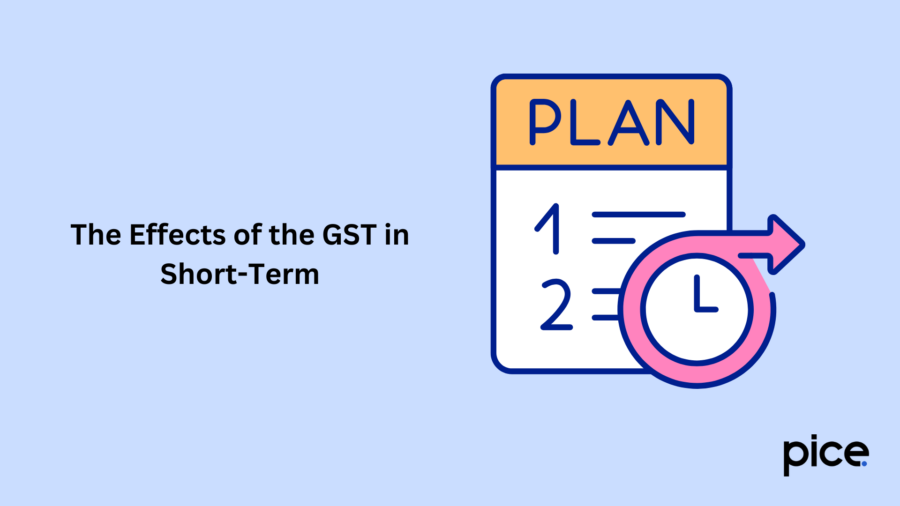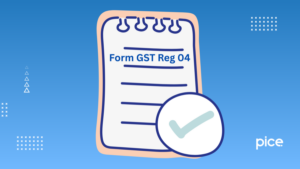The Impact of GST on Government Revenue
- 25 Oct 24
- 9 mins

The Impact of GST on Government Revenue
Key Takeaways
- GST unifies India's tax system, simplifying interstate trade.
- A broader tax base under GST boosts government revenue.
- Eliminating cascading taxes helps curb inflation.
- Regular updates to GST combat tax evasion effectively.
- GST fosters economic growth by enhancing exports and FDI.
The Goods and Services Tax (GST) has transformed India’s tax system, uniting billions of citizens under one of the most comprehensive indirect tax systems in the world, removing trade barriers between states and consolidating various taxes.
This reform is reshaping the economy by merging central, state and local taxes, with hopes that it will accelerate fiscal reforms and drive economic growth. However, concerns remain over the swift transition.
In this blog, you will learn the impact of GST on government revenue and its broader implications.
The Concept of Introducing the GST in India
The Goods and Services Tax (GST) was implemented across all 29 states and 7 union territories with the aim of benefiting everyone. By addressing revenue leaks, it was expected to lower consumer prices and boost government income. Manufacturers and traders would also benefit from fewer GST filings, clearer regulations and simplified accounting.
GST was introduced to streamline taxation, reduce the cascading effect of taxes, ensure uniform tax rates nationwide and promote a more transparent and efficient system.
The Effects of the GST in Short-Term

In the short term, consumers have been paying higher taxes on most goods and services, as many daily items are now subject to equal or higher tax rates. Additionally, the GST introduces compliance costs, which small-scale manufacturers and traders often find burdensome. Some of the key positive impacts of the GST in India include:
- Unified Tax System
GST has unified India’s indirect tax system, eliminating trade barriers between states. This simplification has made it easier for businesses to operate across state lines, improving the overall ease of doing business.
- Price Impact
As many everyday products are now taxed at rates comparable to or higher than under the previous system, consumers have seen a rise in prices for most goods and services. Small businesses face increased operational costs due to GST compliance expenses, which could further drive up prices.
- Transitional Challenges
Initial concerns about disruptions due to the rapid implementation of GST have largely been alleviated, thanks to efficient government execution. The tax is often referred to as a ‘good and simple tax’.
- Complex Tax Structure
India’s GST currently has three types of taxes: state, central and integrated—and five different tax brackets. This complexity is driven by revenue concerns but may eventually be streamlined, similar to other countries with simpler tax rates and slabs.
- Elimination of Cascading Taxes
GST aims to remove the ‘tax on tax’ effect, known as cascading taxes. In the long run, this could reduce inflation and improve key macroeconomic indicators.
- Broader Tax Base
GST has expanded the tax base by bringing more businesses into the formal sector. The number of GST registrations surged from 38 lakh at inception to nearly 64 lakh by September 2017, and by March 2020, there were 1.23 crore active registrations. This 90% increase highlights greater taxpayer compliance and formalisation of businesses.
- Growth in Tax Revenue
GST has led to a steady increase in government tax revenue, despite fluctuations from rate cuts and product rationalisations. This growth has helped manage the fiscal deficit.
- E-Way Bill System
The Electronic Waybill system has improved transparency, reducing tax evasion and enhancing compliance. Despite initial technical issues, the system saw 56 crore e-way bills generated in fiscal year 2019, which grew by 13% to 63 crore in 2020. This reflects increased transparency in interstate and intrastate trade.
- Simplification of Tax Brackets
Over time, fewer goods are being taxed at the highest GST rates and tax brackets have been simplified, receiving positive feedback from both businesses and the public.
- Legal Adjustments
The government has introduced various orders, circulars and notices aimed at reducing tax evasion and streamlining administration. These legal changes have made the GST regime more efficient and reliable, lowering business compliance fees and simplifying the tax system for taxpayers.
The Way Things Will Be in the Future
In the long run, the Goods and Services Tax is anticipated to yield the result of not only low tax rates but also the merging of the tax slabs. The very function of GST is to merge the tax rates of various states. Normally it is operated with 2 or 3 rates like a standard rate, a low rate for the essential items and a high rate for the luxury ones.
India presently deals with 5 tax slabs and several rates mainly including an integrated rate, the central rate and a state rate, in addition to a cess. The government has expressed some reservations over the reduction or the amalgamation of those rates due to apprehension of potential revenue decline. It is not foreseeable in the short run that the reduction to be the case, however, the government has made it clear that the matter will be revisited after the Revenue Neutral Rate (RNR) is first achieved.
Medium-term prospects for the growth of the country should be very promising, as the breaking of the inflation trajectory through the removal of tax cascading should be the main GST effect. In a more energetic tax base, the government budget will be filled with more money while the fiscal deficit will be at a reasonable level.
The number of exports is expected to increase, and a higher level of Foreign Direct Investment (FDI) is predicted to occur. A lot of industrialists believe that business will become efficient and doing is well linked to the introduction of this historical tax reform by the government.
Regeneration of Income from Taxes and Other Sources

The expansion of the tax base is anticipated to significantly increase tax revenue, helping to keep the fiscal deficit under control. Moreover, exports and Foreign Direct Investment (FDI) are also slated for growth. The opinions of industry experts are that these comprehensive tax reforms will lead to an enhancement of the favourable environment for businesses.
To counter tax evasion, the tax rates were made rational and the administrative procedures streamlined. Ensuring the stability of the world’s largest online tax system, the GSTN, has been one of the government's primary objectives. Investing in stocks, bonds and other assets not only provides income through dividends but also via interest and capital gains. The capital market was a catalyst, encouraging the investors to get more returns as well as the income coming from the capital.
Effects of India's Groundbreaking Tax Reform
To understand how effective this biggest tax reform has been, you have to look at some key numbers and indicators. Here is a simple breakdown of the GST's impact:
- Revenue Collection
GST revenue is a key measure of the system’s success. In the first nine months of 2018, the government collected ₹7.4 trillion. By 2019, this figure had risen sharply to ₹11.7 trillion.
Despite challenges like rate reductions and product rationalisations in fiscal year 2020, the revenue for FY19 still reached ₹12.2 lakh crore, representing an approximate 4% increase. Though revenue has experienced occasional fluctuations due to changing regulations and economic factors, the overall trend has been one of steady growth.
- Rate Adjustments
The GST reform simplified tax brackets and rates to make things easier for both businesses and consumers, and significant progress has been made in this area.
Currently, only 3% of goods are taxed at the highest 28% rate. About 25% of goods fall under the 12% bracket, another 25% are taxed at 5% and around 50% are subject to an 18% tax rate. The public's positive reception of these reductions shows the government's commitment to rationalising the tax structure.
Clarifications and Amendments to Existing Legislation
The GST has undergone many changes due to the different needs of taxpayers. In response to these demands, the government has come out with around 30 decrees, 145 circulars and about 700 notices to stop tax evasion and achieve other objectives.
These legal adjustments have greatly enhanced the effectiveness of GST in improving tax collection. The GST has, in fact, had a significant impact on revenue collection which is no doubt a critical turning point in the economic development of India.
Nevertheless, you must consider the potential future outcomes and challenges. As the economy and taxpayer obligations evolve, the GST system will also need to adapt. Preventing tax evasion and ensuring reduced compliance burden for businesses remain top priorities.
Conclusion
The impact of GST on government revenue demonstrated a major impact on the tax system of India and showed that compliance in the various sectors also improved. Apart from the growth in the tax base and the ease of doing the country's processes, the main benefits are the possibility of effective revenue collection and the transparency of the economy.
As the transformation continues, issues such as tax evasion and compliance simplification are of the utmost to deal with. The planned upward trajectory of the GST framework will undoubtedly accommodate fiscal security and further boost economic development in the future.
💡If you want to streamline your payment and make GST payments, consider using the PICE App. Explore the PICE App today and take your business to new heights.
FAQs
 By
By 

















